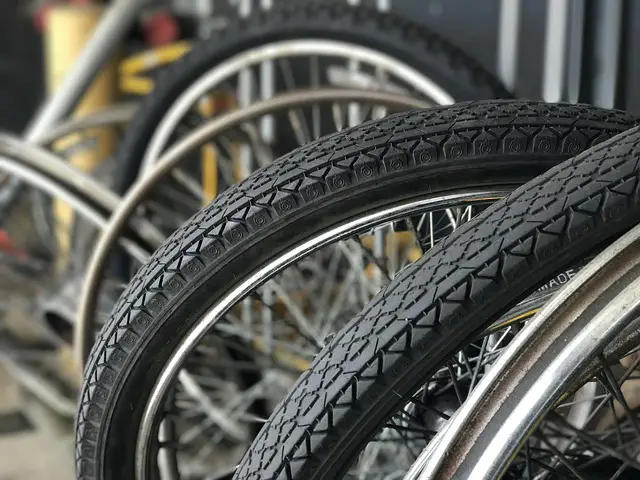
When it comes to hybrid bikes, one of the key components that significantly impact their performance and versatility is the tires. The tires on a hybrid bike play a crucial role in providing traction, stability, and comfort on various terrains, making them an essential consideration for every rider. If you’re wondering whether you can change tires on a hybrid bike, the answer is yes. In fact, changing the tires on a hybrid bike is a common practice among cyclists who want to enhance their riding experience or address specific needs.
However, the stock tires that come with a hybrid bike may not always meet the specific requirements or preferences of every rider. This is where the option to change tires becomes valuable. By selecting the right tires for your hybrid bike, you can optimize its performance and adapt it to different terrains and riding conditions.
Types of Tires for Hybrid Bikes
When it comes to changing tires on a hybrid bike, it’s essential to understand the different types of tires available and their characteristics. The type of tire you choose will depend on your riding preferences, the terrain you’ll be tackling, and the specific performance attributes you’re seeking.
Let’s explore some common types of tires for hybrid bikes:
Smooth/Treadless Tires:
Smooth or treadless tires, also known as slick tires, are designed for riding on paved surfaces such as roads and bike paths. These tires have a completely smooth surface, allowing for low rolling resistance and improved speed on smooth terrains. They are ideal for riders who primarily use their hybrid bikes for commuting, fitness rides, or urban cycling.
Semi-Slick Tires:
Semi-slick tires feature a combination of a smooth center section for reduced rolling resistance and small treads on the sides for improved traction on loose or wet surfaces. These tires strike a balance between on-road efficiency and off-road capability. They provide a comfortable ride on paved roads while still offering some grip on gravel or light trails. Semi-slick tires are a popular choice for riders who enjoy a mix of urban and light off-road riding.
All-Terrain Tires:
All-terrain tires are designed to handle a wide range of surfaces, including paved roads, gravel paths, and light trails. These tires have a moderate tread pattern that offers good traction and control on different terrains without compromising too much on rolling resistance. All-terrain tires provide a versatile option for hybrid bike riders who want the flexibility to explore a variety of surfaces.
Knobby Tires:
Knobby tires are designed for more aggressive off-road riding. They feature a significant tread pattern with larger knobs, providing excellent grip and traction on rough and loose terrains such as dirt trails and muddy paths. Knobby tires offer enhanced control and stability in challenging off-road conditions but may sacrifice some efficiency and speed on paved surfaces.
Read Also: Why Get a Hybrid Bike?
Reasons to Change Hybrid Bike Tires
Changing the tires on your hybrid bike can bring several benefits, depending on your specific needs and riding conditions. Let’s explore some common reasons why you might consider changing your hybrid bike tires:
Performance Enhancement:
Upgrading your tires can significantly improve the performance of your hybrid bike. By choosing tires with lower rolling resistance, you can experience smoother and faster rides, especially on paved surfaces. High-quality tires with advanced rubber compounds can also enhance grip and cornering capabilities, allowing you to ride with more confidence and control.
Terrain-Specific Adaptation:
If you frequently ride in different terrains, changing your hybrid bike tires to suit specific conditions can greatly enhance your riding experience. For instance, if you often encounter loose gravel or dirt trails, switching to wider all-terrain or knobby tires can provide better traction and stability. Similarly, if you primarily ride on paved roads, opting for slick or semi-slick tires can optimize your bike’s performance for smoother surfaces.
Seasonal Considerations:
Changing your hybrid bike tires based on the season can be beneficial, especially if you encounter different weather conditions throughout the year. For wet or rainy seasons, you may consider tires with specialized tread patterns or additional puncture resistance to improve grip and minimize the risk of slipping. In contrast, for dry summer months, you might opt for tires that prioritize low rolling resistance and speed.
Puncture Protection:
If you frequently encounter debris, glass, or thorny surfaces during your rides, switching to tires with enhanced puncture protection can save you from frequent flats and reduce the chances of unexpected disruptions. Some tire models incorporate features like reinforced layers, thicker sidewalls, or specialized puncture-resistant compounds to offer better resistance against punctures.
Comfort and Ride Quality:
Tire selection can also impact the overall comfort and ride quality of your hybrid bike. Wider tires with lower pressure can absorb more road vibrations and provide a smoother and more comfortable ride, especially on rough or uneven surfaces. Additionally, tires with better shock absorption properties can reduce the impact on your body, enhancing overall comfort during longer rides.
Read Also: Is Trek a Good Hybrid Bike?
How to Change Tires on a Hybrid Bike
Changing the tires on your hybrid bike may seem like a daunting task, but with the right tools and a step-by-step process, it can be easily accomplished. Here’s a general guide on how to change the tires on a hybrid bike:
Gather the Necessary Tools:
Before starting the tire-changing process, gather the following tools: tire levers, a pump, a wrench (if your bike has quick-release skewers), and a patch kit or spare inner tube.
Prepare the Bike:
Flip your bike upside down or place it in a bike stand to provide easy access to the wheels. If your bike has rim brakes, release the brake tension by squeezing the brake calipers and unhooking the cable.
Deflate the Tire:
Use the valve cap removal tool (if needed) to remove the valve cap and then press down on the valve to release all the air from the tire.
Remove the Tire:
Insert one of the tire levers between the tire bead and the rim. Use the lever to pry the bead over the rim edge, then hook the lever onto a spoke to keep it in place. Repeat this process with a second lever, a few inches apart from the first. Slide the second lever around the rim, lifting the tire bead over the rim edge. Continue sliding the levers around the rim until one side of the tire is completely off.
Replace or Repair the Inner Tube:
Once the tire is partially or fully off the rim, remove the inner tube from the tire. If you’re replacing the tube, simply install a new one that matches the tire size and valve type. If you’re repairing a punctured tube, locate the puncture using water or soapy solution, dry the tube, and patch it using a patch kit following the manufacturer’s instructions.
Install the Tire:
Start by inserting the valve stem into the valve hole on the rim. Work your way around the rim, gradually pushing the tire bead onto the rim edge using your hands. Be cautious not to pinch the inner tube. If necessary, use the tire levers to assist in seating the tire bead onto the rim, but be careful to avoid damaging the tube.
Inflate and Inspect:
Once the tire is fully installed, inflate it gradually, periodically checking that the tire bead is properly seated on the rim. Use a pump with a pressure gauge to reach the recommended tire pressure specified on the sidewall of the tire. Once inflated, inspect the tire to ensure it’s evenly seated and there are no bulges or areas where the tire is not properly seated on the rim.
Reinstall the Wheel:
If your bike has quick-release skewers, align the wheel with the dropouts and tighten the skewer by hand. If your bike has thru-axles, insert the axle through the hub and tighten it using a wrench or an appropriate tool. For bikes with rim brakes, reattach the brake cable and adjust the brake tension if necessary.
Test the Tire:
Before riding, give the tire a final inspection to ensure it’s properly seated and there are no signs of misalignment or damage. Spin the wheel and check for any wobbling or rubbing against the brake pads. If everything looks good, take a short test ride to verify that the tire is functioning correctly and securely.
Read Also: What is the Best Men’s Hybrid Bike?
Conclusion
The ability to change tires on a hybrid bike is an important consideration for every cyclist. Whether you want to switch to a different tire tread for specific riding conditions or replace worn-out tires, being able to change tires gives you the flexibility to optimize your bike’s performance and comfort.
Hybrid bikes are designed to accommodate different tire sizes and tread patterns, making it relatively easy to change tires. By following the steps outlined in this guide and using the right tools, you can confidently swap out tires on your hybrid bike.
Remember, when changing tires, consider factors such as tire size, tread pattern, riding conditions, and your personal preferences. Take the time to research and select the right tires that suit your needs. Additionally, it’s important to pay attention to proper tire inflation, rim tape condition, and tire direction to ensure optimal performance and safety.
If you’re unsure about the tire-changing process or encounter any difficulties, don’t hesitate to consult a professional bike mechanic. They can provide expert guidance, address any concerns, and ensure a smooth and successful tire change.
